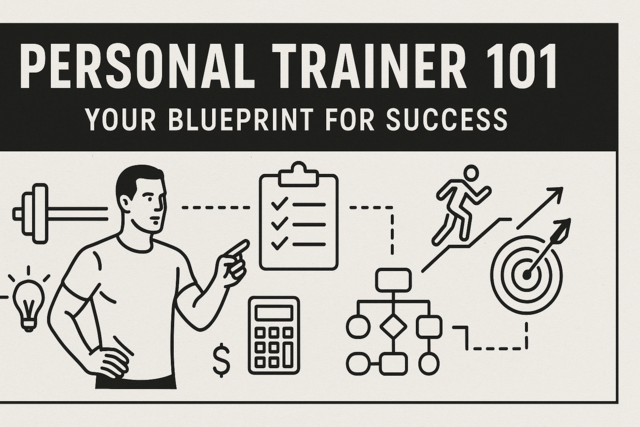Introduction: There is no one path to becoming a personal trainer. Each person has an individual timeline and methods because of their unique experience, skills, and abilities. The plan to become a "business person" in your own right will be shaped by your individual goals, wants, and needs. Just like your goals, your business plan is a fluid document and it is not just about finances. What you plan to do in your career today may change according to what happens in your life, what you learn, what you experience, and what you value. This article will take you through the steps of beginning a business as your own boss, as a part-time freelancing trainer on the side, or as you retain employment with an established fitness center. It is your plan. As you work through each section you will have to make decisions. Take charge of your life and make those decisions now. That does not mean you cannot change and adjust them as often as you want or even begin again.
Don't be afraid to step out. Don't be afraid that you won't be able to do something or that you will fail. If you don't try, then you are essentially failing. To try and push yourself beyond what you think you are capable of doing and not get there is not failing. You still got farther than you would have gotten had you stopped and not made the effort. Sometimes the experience along the way is an education that is worth more than any you could pay for. Everything you try, every new experience will take you to a higher level of knowledge, understanding, or awareness about people and the world around you. Nothing is lost when you try, everything is gain.
A. The business plan is a guide so just jump in and begin. It will make you think about issues that a person would not normally consider when thinking of career choices, yet very important. In this article you will build a rough outline of the plan that will be changed, adjusted and perfected along the way.
Your business plan will be based on your goals. Get those out and use them as a reference.
Business Plan Document will include the following:
1. Goal: Write the goal/goals that focus on your career path.
2. Personal Strengths and Weaknesses: You should have these already written down. Rewrite them here.
3. Why you have chosen this career path: If you need to apply for financial aid, this will be a question that will be asked of you. If you go to work for an established company, the information in this document will show them that you are professional in how you think.
4. Federal, state, and local requirements to become a personal trainer: All of this needs to be considered and put into this plan for your business. Stop now and find this information.
5. List some statistics about the growth and opportunities in your area, for professional personal trainers both nationally and locally: Again, this will help you get financing if and when you need it. It is online.
6. What are the possible marketing strategies you will use: Website, SEO, Google/Facebook Ads, Social media, blogging, flyers, posters, referral cards or business cards, media/press, events, speaking to potential clients in the gym, networking. (Add only those that you might be willing to use)
7. What can you offer that will bring you success over others: Again you have to sell yourself and express your willingness to work hard. Refer to your strengths.
8. Develop a cost to gain accreditation and where you will do that: ________________________________________________________________________
9. If you will require equipment up front, list the equipment and costs here and your plan to pay for that equipment (borrow money, budget for it each month, etc.): ____________________
10. Develop a cost per service sheet: In this article, in part B, you will be guided in how to pull this together.
11. Develop a budget for yourself for when you begin your work as a personal trainer: In this in part C, you will be guided through this.
12.Financials:
Money you will earn (include regular pay if working for an established center plus freelancing work after hours)- see part C: ______________________________________________.
Subtract and find the difference and decide how you will resolve that difference if your cost is more than your income.
What expenses you must cut back on, or how will you increase earning. If you don't work this out, you will find yourself living on charge cards and constantly in debt. Not a good plan.
Now list the cost of what it will take to get you live from now until you are actually working and creating income as a personal trainer? ________________________________________________.
What is your plan to meet that cost or the possibilities that you are looking into? List them here: ________________________________________________________________________ ________________________________________________________________________
(They may include a current job, savings, parent help, loans, grants (see the Live Strong Foundation) or if the need is great in your area, you may get a fitness center to pay for your certification.)
B. Developing a Cost for Services Sheet: When you get a new client, the first thing they will want to know is how much it will cost them. You will need to be prepared with your charges per hour or per package. You will base this on the going rate in your area, and probably want to begin with a slightly lower cost if you are new, but not too much lower. If you are too low, people will wonder why. Also you don't want to attract those who are looking for something for nothing. You are charging for more than your time. You are charging for your knowledge, ability, and experience. The cost per hour is fairly easy to figure out. Just make some calls and see what the going rates are. It is often better to offer packages. For example; a beginner package might offer a special rate to see if the client really is ready to commit and if the two of you click.
You might offer a 5-week package with one or two main sessions per week that include a schedule for independent work on days they do not train with you. You can offer special rates for groups, for beginner training, and for senior citizens or children. If you specialize in working with homebound individuals, you can charge more for your costs of transport and the individuals might be able to use their insurance to pay for your services, if ordered by a doctor. You will ask them individually to check this out through their doctors.
Here are some important reminders that experienced professional trainers know. You do not want to constantly have to bring up money or try to get your client to pay their bill. You have to charge up front. Have your cost sheet ready to present to each prospective client. In the first visit steer them away from the costs until you have asked them about their goals, what they want to accomplish and where they are currently with their physical fitness. Assessing their need for your services is a better way to lead into your charges. Then hand them the sheet.
The client will be more committed to their attendance and you will be paid for your time if they show up or not, if you make it a policy to have them pay up front. You cannot work at the whim of a client. You will also retain more clients for a longer period if you sell them packages or a series of sessions. The goal is to get a client to become a regular source of income for you. You do this by enlisting them in long term contracts and by working hard to help them achieve their goals.
It is recommended by the experts that you charge a higher rate for a single session than for package deals as opposed to a regular rate for a single session and less for a package deal. If people cannot afford you that is not your problem but theirs. They will have to work out their own problems. You cannot "help" them along by giving them discounted rates. You have to pay your own bills. For example, if the going rate is $60 and hour, set your single session (or less than three sessions) at a rate of $75/hour. Set your package rates like 10 sessions for $600 and make sure they pay up front and sign a contract that clearly states you are paid if they show up or not. It is wise to put in a clause that if given 24 hours' notice they can change the time of their session. You will have many clients and you cannot be pulled and pushed about due to all of their schedules. You must maintain your own scheduling in an organized way. If they have scheduled Tuesday and Thursday at 11:00 and can't be there on Thurs, then let them know what time YOUR schedule is free to work them in. Take charge of your life and your business. You can do this respectfully, and to be professional, you have to work this way. Good clients will appreciate your professional attitude. If not, let them go, but after their contract runs out.
You can always tell a client that after their first 10 sessions you give a 10% discount. That might be worth it to retain them as a client. Give the discounts to those who are loyal over time, not to those who come once or twice and may not come again. Many in business do not understand this and they are unable to sustain their ability to stay in their career for the long haul.
C. Developing a Budget: You have to know how much money it will take you to exist. If you think you can wing it, think again. You will miss something. Writing down every expenditure will not only make it real but will keep you focused on your spending habits, saving habits, and how those connect with your values. What you don't know can hurt you. You have to plan for the unexpected because the unexpected, though not expected, will happen when you least expect it.
Write down the cost for each of the following for one month. If you don't know then look back at what you spent last month and use that.
1. Rent/house payment/insurance/taxes
2. Groceries and household necessities
3. Eating out
4. Recreation (movies, books, drinks, bowling, Netflix, other subscriptions)
5. Utilities - electricity, gas, water, sewer, trash disposal, cable, phone, internet,
6. Clothes, cleaning, laundry, shoes, accessories (jewelry, purses, coats, ties)
7. Business supplies (special clothing, pamphlets, cards, ads, blogs, insurance, equipment costs)
8. Transportation (car payment, property taxes, tags, insurance payment, upkeep-tires, oil, parking)
9. Gifts/things that come up or miscellaneous
10. Debt payments (credit cards, student loans, other debt)
11. Charitable contributions
12. Savings
As you work through this budget of expenses you will begin to get an idea of what you need to earn. If it doesn't balance out there are things you can do. You can work two jobs. You can cut your costs. You have choices to make. Cutting spending is not as difficult as it seems but you have to be in control of yourself and be willing to say aloud to friends and family, "I cannot afford that" or "It's not in my budget." Let people know that you are on a quest to stay out of debt and going to a movie is not worth blowing your set goals.
To cut costs you can live in a cheaper place, get a roommate, let go of cable, get a pay as you go phone and use it minimally, stop eating out, buy only healthy food and end junk food purchases. You can drink water, cut out all cleaning supplies except one for general use, create fun things to do that don't cost money, like walking, running, playing games (inside and outside), and reading. Get healthy, develop hobbies that are inexpensive like juggling, writing, knitting (you can buy old sweaters at the thrift store cheap and reuse the yarn), shopping garage sales, etc. You can buy your clothes at second hand shops. If you love animals, instead of getting one which is costly, volunteer your time at an animal shelter. Use free opportunities in your community, like the library, community colleges, local museums, etc. Get your debts paid off as fast as you can and limit your charitable contributions. Lastly, you must get into the habit of saving. That is not saving to make a splurge purchase later. It is saving for the time you will be unwilling to work. Make sure you have and keep health insurance. It may initially feel like an unnecessary cost, but in time it will save you thousands. You can be healthy today and fall ill tomorrow. It is a chance you cannot take.
Now you are ready to see if your income covers your expenditures. Get this information organized and into your journal you are making for this class. This is important and though it may change over time, you have to have a working document to stay abreast of your future.
Conclusion and Assignments: Creating a plan for your business does not have to be formal, technical, or constricting. A life plan, a business plan is just that - a plan. It is fluid, adjustable, and a work in progress. It is important. It is important to think about, to write down, and to refer to often. It is essential to any person who doesn't want to stay stagnant.
To sum up your assignments for this article:
1. Complete the answers to each of the 12 steps in the business plan, part A.
2. Complete the answers to the cost for services sheet in part B.
3. Complete the budget numbers in part C.
4. And lastly but most importantly, reflect on what you have done.
|
P.T. Tips
Find a specialized niche in your locale that is not being met. Often there is great demand for people who cannot get out, people who are disabled and people who are in jobs where heavy lifting is required. Some companies would pay you to give regular classes on how to strengthen the back. People who sit all day, even professional white collar companies hire trainers to come and give employees ideas that will help them stay healthier and ways to get some exercise as they are working at their desks. Always send thank you notes when clients sign up to work with you and listen to them when they talk. Know their goals and pay attention to them.
|































